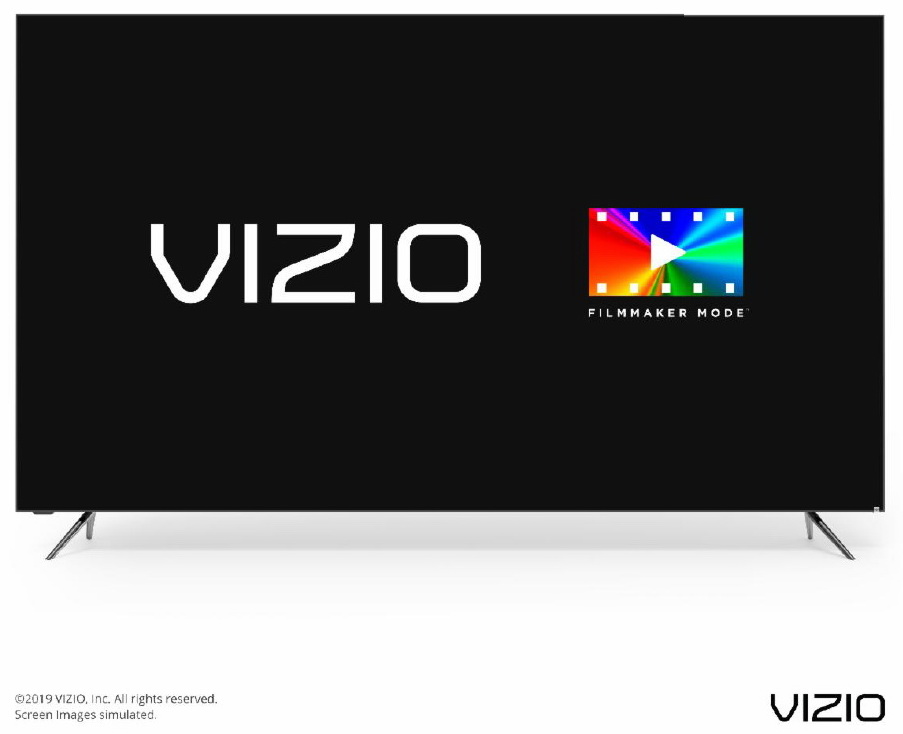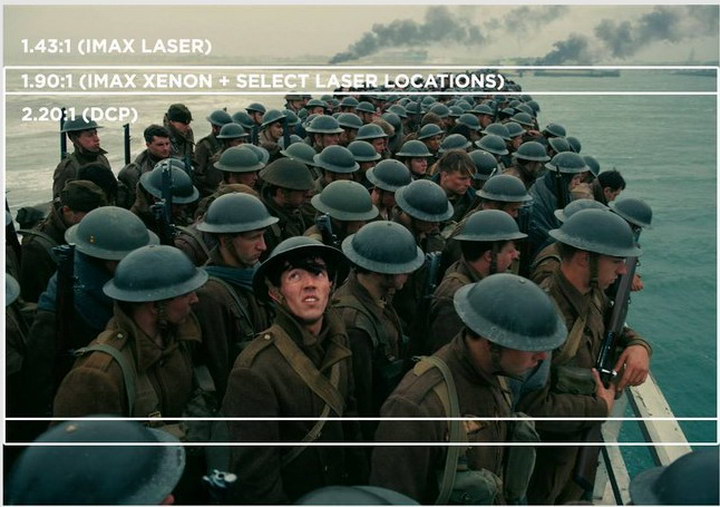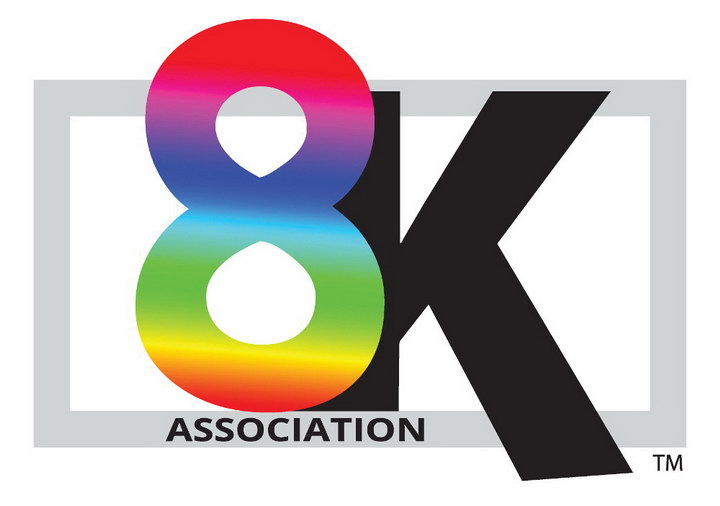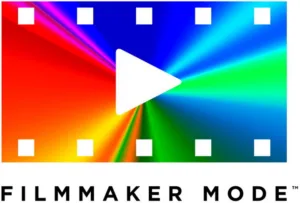In the run-up to IFA in Berlin September 6 – 11 and the IBC in Amsterdam September 13 – 17, there have been a number of interesting announcements related to video technology. Two I’m going to talk about in this Display Daily are the announcement of the new Filmmaker Mode from the UHD Alliance and the announcement of new 8K specifications from the 8K Association.

Filmmaker Mode Logo from the UHD Alliance (Credit: UHD Alliance)
On August 27, 2019, the UHD Alliance (UHDA) announced the introduction of “Filmmaker Mode.” This is a setting for UHD-1 (AKA Ultra-HD and 4K) TV sets that turns off all post-processing and allows you to see exactly what is on the video source you are using. They claim this will allow you to see the movie as intended by the director without TV post-processing that can change the original vision of the movie by the director. In particular, Filmmaker Mode will turn off any motion processing in your TV set that interpolates from the 24Hz film to the 50Hz, 60Hz, 100Hz or 120Hz or higher speed TV field rate. How the set will display the 24Hz content is not specified by the UHDA but presumably it will involve a 3:2 pull down for 60 or 120Hz sets.
Virtually any TV already allows the viewer, through the TV menu system, to disable the post-processing features that Filmmaker Mode will disable. Filmmaker Mode will be activated either automatically, through metadata embedded in the content, or through a single button on the remote control which enables the consumer to activate Filmmaker Mode without moving through multiple menu levels. The name and settings for Filmmaker Mode will be consistent across multiple TV brands. Note that Filmmaker Mode is not a DVD, Blu Ray or streaming media encoding scheme to provide you with content as intended by the director. Instead it just adjusts your TV settings.

The TV Launch partners for Filmmaker Mode are LG, Panasonic and Vizio. Vizio has already issued a press release saying Filmmaker Mode will be included in its 2020 Smart TV lineup. I haven’t seen announcements from LG or Panasonic yet but I wouldn’t be surprised to see product from them in 2020 too.
The UHD Alliance has posted a video on its website and YouTube to introduce the Filmmaker Mode. This has had 26,042 views on YouTube as of Noon 9/3/19. This is not the total viewership, since I watched it twice, one directly on the UHD Alliance website and once on YouTube. Interspersed in the video among the audio/video comments from directors are text quotes from the UHD Alliance including:
“Filmmaker mode displays movies and television shows as they ere intended by the filmmaker.”
“Filmmaker mode disables all post-processing (Motion smoothing, etc.) preserving the correct aspect ratios, colors and frame rates.”
“Filmmaker mode will be easily accessible on TVs from multiple manufacturers.”
Being careful about TV setup to get the best possible image is, in fact, nothing new and the 117 comments posted as of 9/3/19 in reaction to this video on YouTube were mixed but generally unfavorable. Many of the comments were of the nature “Why do we need Filmmaker mode?” For example, Robert Zohn, owner of Value Electronics in Scarsdale, NY and host of the annual TV shootout, commented on the YouTube website about the Filmmaker Mode introductory video:
“Since Wendy and I started Value Electronics in 1998 we trained our techs and clients to do everything that is recommended by the UHD Alliance in the new “Film Maker Mode” initiative. Tens of thousands of TV and projectors we’ve sold in the past 22 years have been set-up properly to enjoy the best and most faithful image quality that is built-into films since the invention of Cinema.”
BTW, Filmmaker mode on a TV won’t calibrate a TV the way Value Electronics does. It just turns off picture enhancement features.
Another comment on YouTube from Andrew Turner said, “I’m glad my Sony TVs already recreate the Filmaker’s intent with Cinema and Netflix Calibrated modes.”
Part of a comment from John Hooper read “…Cinema Mode, True Cinema Mode, Netflix Mode, Technicolor Picture Mode, Expert Mode, Professional Mode and now Filmmaker mode… And you wonder why the customer is confused.”
One favorable comment from Aly Rana, a filmmaker himself, deserves special attention: “Can finally watch DUNKIRK the way Nolan intended it!”
Here part of the question is “How did director Christopher Nolan intend Dunkirk to look?” Nolan is featured in the Filmmaker Mode video from the UHD Alliance along with multiple other directors. Basically, each of the directors said “You won’t see a movie the way I intended it unless you see it in Filmmaker mode,” without saying how they intended it to look. Dunkirk in the theater had many different looks, including multiple aspect ratios and resolutions.
Bob Raikes did a Display Daily on this topic just after the movie came out in 2017. He included an Infographic by @Antovolk that showed how Dunkirk was released theatrically in five different aspect ratios: 1.43:1, 1.90:1, 1.91:1, 2.20:1 and 2.40:1. It was also released theatrically in multiple resolutions, including two versions of 70mm film, 15 perf with a resolution of about 18K and 5 perf with a resolution of about 12K; 4 Perf 35mm film with a resolution of about 6K; and DCP versions for a 4K dual laser projector instillation, a single projector 4K version with 3996 x 1818 resolution and a 2K version with 1998 x 909 resolution. Before digital cinema, the 4 perf 35mm format was the standard release print, although back in those days release prints did not have 6K resolution, it was more like 1.3K.
 A key scene from the DCP version of Dunkirk and how it was shown in different theaters. The 15 perf 70mm film version also had a 1.43:1 aspect ratio. (Credit: Warner Brothers, from an Infographic by @Antovolk)
A key scene from the DCP version of Dunkirk and how it was shown in different theaters. The 15 perf 70mm film version also had a 1.43:1 aspect ratio. (Credit: Warner Brothers, from an Infographic by @Antovolk)
The basic image had a 1.43:1 aspect ratio – if you saw a version in the theater with any other aspect ratio, you missed the top and bottom of the image, including the ships burning in the background. These burning ships were certainly intended by Nolan to be seen, otherwise they wouldn’t have been there. I saw (Twice!) the 15 perf version on 70mm film with a 1.43 aspect ratio and about 18K resolution and was blown away by the image quality. I’m sure that’s how Nolan intended the film to be seen but there is no button on your TV remote control that will allow you to see that 18K resolution.
In addition, the Blu Ray/DVD combination pack for Dunkirk was released with 1.78:1 and 2.20:1 aspect ratio versions. This combination pack actually has three discs in it, single layer BD25 with 25 Gigabytes, dual layer BD50 with 50 Gigabytes plus a DVD. No button on your remote control is going to allow you to see those burning ships, either. So, sorry Aly, you won’t be able to see Dunkirk as Nolan intended it. Instead, you will see it as the anonymous people in the Blu Ray production facility that mastered the disc intended it. Will there ever be a “Director’s Cut” of Dunkirk with a 1.43 aspect ratio? Maybe when it comes out on an 8K disc…
 8K Association Logo
8K Association Logo
In related news, the 8K Association (8KA) recently introduced performance specs for 8K Televisions. The basic specifications have been publicly released and are:
- Resolution: 7680 x 4320 pixels
- Input Frame Rate: 24p, 30p and 60p frames per second
- Display Luminance: More than 600 nits peak Luminance
- Codec: HEVC
- Interface: HDMI 2.1
Additional details on the performance and interface specifications are available to members. These newly released tech spec details for members include specifications for 8K input parameters such as bit depth, frame rate, chroma sub-sampling; display performance such as resolution, peak brightness, black level, color gamut and white point; and the interface and media formats such as high dynamic range (HDR) requirements and codec.
While the details are only currently available to members, the 8K Association is growing – apparently there is interest in 8K technology at television technology companies, even if 8K might be a hard sell at the consumer level. Members include AUO, Hisense, Panasonic, Samsung, Samsung Display, TCL, Tencent, Xperi, Novatek, V-Silicon, Chili, Louis Pictures, InnoLux, Astro Design, Ateme and Intel.
According to the 8K Association, 8K shouldn’t be a hard sell at the consumer level, either. They say the arguments against 8K are basically the same as the arguments used a few years ago against 4K:
- You can’t see the additional resolution
- The production costs are too high
- There is no native 8K content
- 8K requires more bandwidth for distribution
The 8K Association has a number of links to articles supporting its position that these arguments are not valid in the long run posted on its Resources page.
I addressed the issue of 8K content production in an earlier DD after the 8K Display Summit last June so I won’t repeat that except to say some of the experts that commented on that DD were dubious about the value of 8K as a consumer distribution format. Well, so am I. Studies have shown that High Frame Rate (HFR) brings more visible improvement to the consumer than higher pixel counts. I’d like to see more effort put into HFR and worry about resolution beyond 4K a few years from now. When giant displays (>85”) become common in the consumer space, 8K will make (some) more sense, especially if you cram an 85” TV into a typical living room, forcing you to sit very close to it, less than one picture height away.
The 8K Association will be at IFA in Berlin September 5 – 7. Anyone interested in learning more about the association can talk to them there and should contact the 8KA Executive Director and regular Display Daily contributor Chris Chinnock to make an appointment. – Matthew Brennesholtz

